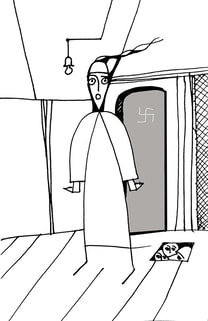Destruction of Jewish community of Izyaslav
|
Background
First killing action
Ghetto
Second killing action
Third killing action
Sveta Korosty’s story
Background
Germany’s invasion of Ukraine in 1941 led to the total destruction of the Jewish households in Izyaslav. Now only 9 Jews reside in Izyaslav but in 1939, before the war, about one third of Izyaslav’s population, 3200 people, was Jewish. The Germans captured Izyaslav on July 5, 1941, and it didn't take long for the mass executions to start. A few local Jews managed to escape to the Soviet interior when the Germans arrived, while the remaining Jews were ordered to wear yellow badges on their chests and backs. Many of them were made to perform forced labor. First killing action
Records from the Yad Vashem Holocaust Center contain an account of these tragic event: “On August 30, 1941 the local police and the Germans surrounded the city early in the morning. The Jews, mainly women, children, or elderly, were driven out of their homes by Ukrainian auxiliary policemen. The Jews were told to take all their valuables with them on the pretext that they were going to be sent for the “resettlement in Palestine”. After being collected, the people were loaded onto trucks and taken to anti-tank trenches on the Poboy tract in the forest near the town. There the victims were made to strip naked and taken in groups to pits. They were made to lie face down in the pits and shot to death in the back by members of Police Regiment South and some Ukrainian policemen. Each group was forced to lie on top of the previous victims and killed the same way. The shooting lasted until nightfall. After the shooting the pits with the bodies were covered with earth.” On that day, about 1000 Jews were murdered in Poboy antitank caponiers on the western outskirts of town. Ghetto
After the first killing operation, a ghetto comprising about 20 houses was set up near the Old Synagogue building in the old city and the remaining Jews of Izyaslav and nearby localities were brought there. The ghetto was surrounded with barbed wire and a wooden fence and guarded by the local police. The Jews stuck there were used for hard labor and not allowed to leave. Many of them died during the construction of the dam on the Gorin river and were buried inside it Second killing action
Records from the Yad Vashem Holocaust Center contain an account of the second mass killing: “In June 1942, Ukrainian auxiliary policemen surrounded the ghetto and ordered its inmates to come out of their homes. 137 specialists – artisans and craftsmen, with their families – were allowed to remain in the ghetto. The rest of the Jews were loaded onto trucks and taken to the forest near the village of Soshne, several kilometers west of the town. There they were shot to death in several large pits by a German unit and some Ukrainian policemen.” Third killing action
Records from the Yad Vashem Holocaust Center contain an account of the second mass killing: “In June 1942, Ukrainian auxiliary policemen surrounded the ghetto and ordered its inmates to come out of their homes. 137 specialists – artisans and craftsmen, with their families – were allowed to remain in the ghetto. The rest of the Jews were loaded onto trucks and taken to the forest near the village of Soshne, several kilometers west of the town. There they were shot to death in several large pits by a German unit and some Ukrainian policemen.” Sveta Korosty’s story
Sveta’s Jewish mother Rita Yakovlevna Goldshtein was a former student of Saveliy Korosty. The teacher and the student fell in love, got married and had Svetlana in 1938. In 1941, the Korostys brought Sveta to Izyaslav and left her in the care of Rita’s parents for the summer, as they had done in previous years. Tragically, the war started on June 22, 1941, and the German army quickly occupied Izyaslav and most of the Ukraine, separating Sveta from her parents. Both parents survived the war. Savely Korosty became a commander of the 1825 Тank Regiment, and to toward the end of the war he was promoted to the rank of а general. After the war, the Korostys came to Izyaslav to pick up their daughter, then they learned the shocking news about death of Svetlana and her Jewish grandparents. The Korostys were devastated. Sveta’s father requested that he be buried near his daughter and asked for the following words to be on his monument: “I come to you my dear daughter...” |



